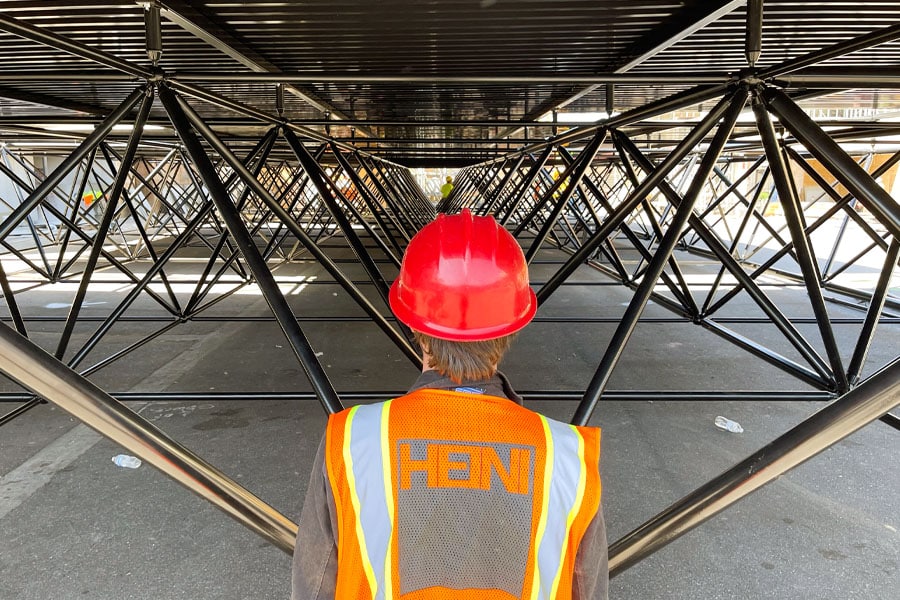When McCarthy Building Companies recently surveyed its craft professionals to find out what job benefits were important to them, the answers might have surprised industry leaders from a generation ago. Back then, the conventional wisdom was that electricians, plumbers or other skilled construction tradespeople were fine with just a paycheck.
But for anybody who tracks what today’s workers say they want on the job, the survey results were a no-brainer—and a paycheck isn’t all they expect. “They want stability,” said Lisa Sanders, McCarthy’s vice president of human resources operations. “They want to learn and enjoy their job and have opportunities to grow and develop. They want those benefits.”
Pay, of course, still matters. According to staffing agency EmployeeBridge’s 2022 Voice of the Blue Collar Worker, nearly 40% of respondents rated pay as the No. 1 factor when looking for a job. Yet when asked what would earn their loyalty beyond pay, respondents said they wanted advancement opportunities, a flexible work schedule, a 401(k) retirement plan and health insurance contributions.
And, in today’s battle for workers amid historic labor shortages in the industry, construction companies like McCarthy are doing more—using broader benefits packages to attract and keep workers.
“You’ve got to make it attractive enough that they want to come and work and they want to show up every day, and they feel like they are valued,” Sanders said, “and that there’s something more than just a paycheck.”
Reinforcing the message
McCarthy, a general contractor with 6,500 employees across the country, has been extending new benefits to tradespeople—from paid leave for funerals and military duty to 401(k) plans, health insurance, mental health support and learning and development opportunities. And while many of its peers have a 90-day waiting period for benefits, new McCarthy employees get them at the 30-day mark—a perk touted during the hiring process.
“It’s just reinforcing the message that benefits are really important, and we value them as employees,” Sanders said. “Some of our long-term crafts employees are like, ‘Holy cow, this is awesome.’ And some younger folks never knew that wasn’t really an option. It’s just an expectation they have.”
To appeal and engage workers today, especially those younger generations, here are five ways to build out or reframe benefits.
Make learning possible
With the help of craft trainers and instructional designers, McCarthy is developing programs focusing on both hard and soft skills for workers at every level of the company. A laborer might learn appropriate office behavior or the proper way to use power tools. A skilled craftsperson ready to become a foreman might take a class on communications skills.
Still, McCarthy has found that it’s not enough just to offer the training; it also must ensure that crews are aware of the programs and can participate in them. It recently began opening craft training sites near its major locations and built a training trailer that can go on the road. “It’s trying to meet our craft professionals where they are at and at the level that they need,” Sanders said.
Reimagine your benefits
Today’s workforce includes five generations, and each one brings different needs to the table. “There is no one benefit that meets everyone’s needs,” Sanders said. “It’s about offering benefits that provide the most flexibility.”
In recent years, McCarthy has reimagined its benefits, moving away from offering vacation and sick time to simply paid time off, so workers can take time for whatever reason. It also changed “parental leave” to “family leave.” “It’s not just about new parents; it’s about anyone,” Sanders said. “If you have sick children, if you have sick parents, you can take paid family leave.”
Consider financial wellness
New kinds of perks can be attractive, too, and financial wellness programs are particularly useful for workers nowadays, said Kimberly Prescott, president of Prescott HR, a human resources consultancy. These programs are often available through a company’s 401(k) or benefits provider, so they can be easy to implement.
Programs benefit employees by giving them the knowledge and skills to boost their financial health. They can also help companies. When workers are no longer stressed about money, “they’re more productive,” said Prescott, whose clients include contractors. “They show up differently, and it makes the organization better.”
Share the total package
Completely redesigning benefits packages and adding every perk imaginable isn’t possible for most companies. Sometimes workers just need to be reminded about what’s already offered—the total compensation package, Prescott said.
A worker’s annual wage might add up to $50,000, but once the cost to the employer of every benefit—health insurance, a 401(k) contribution, paid time off (PTO) and learning and development opportunities—is tallied up, the company could be spending $75,000 on them, she said. Especially if a worker is considering a job offer elsewhere for a slightly higher hourly wage but fewer benefits, reminding workers about what they already have can keep them on board.
Employers must be deliberate about outlining that total compensation package, Prescott said. A good time is during their annual review with their manager. Those conversations might even prompt workers to take advantage of a benefit they didn’t before—a career advancement opportunity or a bigger 401(k) contribution.
“Don’t make it perfunctory,” Prescott said. “Otherwise, it’s going to fall through the cracks.”
Take one small step
When it comes to the work required to attract and retain workers, it’s easy to get overwhelmed. But a sweeping update to your benefits package isn’t the only thing that will move the needle. First steps can make a difference, Sanders advised. “Do one thing. And then one thing becomes two and two becomes three … Small, incremental change is actually still change.”












